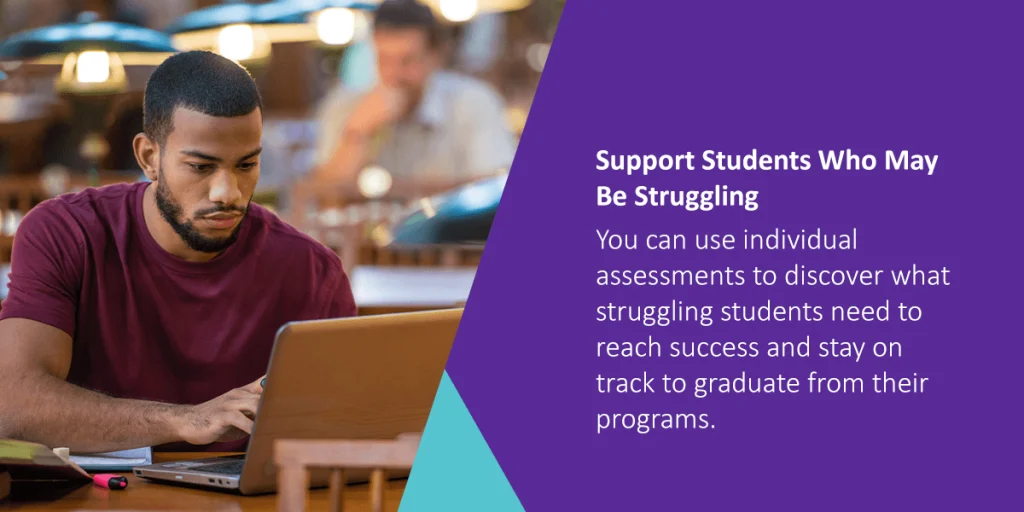Student data is more than test scores or graduation rates. To truly promote student success, institutions must look beyond individual data points to get a holistic view of student performance. Using robust student data helps institutions more effectively drive change and foster a supportive environment for learning and growth.
But how can institutions like yours capture, understand, and act on student data that will help you empower your faculty and students, create engaging classrooms, and set new goals? Read on to discover ways to use student data to improve educational outcomes and institutional success.
What Is Student Data?
Student data encompasses all information that depicts student learning and their needs. Campus culture, academic performance, and behavior are all forms of student data. Using student data to improve teaching and learning can lead higher education institutions to discover new pathways to success and identify potential roadblocks for students. Finding new solutions can improve student retention and engagement and lead to new initiatives to help your institution stand out.
5 Ways Student Data Can Improve Student and Institutional Success
There are many ways you can use student data. After deciding what goals you want to set your sights on, you can determine how to collect student data and how to apply it. Here are five ways to use the data you collect to create lasting changes at your institution.
1. Forecast student success rates to raise admission ROI
Graduation and program completion rates can be excellent metrics to determine admission return on investment (ROI). Retention is more profitable than enrollment, so ensuring your current students have what they need to succeed can help you save millions while ensuring each student leaves your institution with the high-quality education you promised.
When you dedicate thousands of dollars to helping students through the enrollment process with advertising, marketing, scheduling tours, and developing recruitment programs, you want to see them cross the finish line. When students drop out or transfer, you don’t see a return on your investment to get them there.
When you can accurately predict student performance, you can determine how much of a return you’ll see and how much you can dedicate to recruiting new students, effectively saving your institution money and ensuring more students reach success.

2. Support students who may be struggling
You can use assessment data to improve performance by identifying the pain points in a student’s experience. You can use individual assessments to discover what struggling students need to reach success and stay on track to graduate from their programs. You can distribute self-assessments to understand the student experience and allow them to tell you what they need.
This information lets you learn more about your students’ personalities, abilities, strengths, weaknesses, and learning styles. Instructors and decision-makers can use this data to transform classrooms, adjust teaching practices, and reflect student views on campus culture.
Additionally, you can connect with struggling students to ensure you can deliver the immediate resources and assistance they need to pass classes, complete their programs, and dive into master programs or the workforce. You can reduce the number of students who drop out or transfer to other institutions by meeting them where they’re at and delivering what they need to succeed.
3. Evolve curriculum to match student demands and needs
Formative assessments can help depict how teachers use data to improve instruction and meet student needs. For example, brief quizzes, informal assignments, and a show of hands can all detail whether the educator is closing the comprehension gap. When students detail a topic that is too complex, or the instructor moves too quickly or slowly, the educator can plan lessons accordingly.
Summative or key assessments can also be used by the instructor, program, or department to ensure that students achieve the intended learning outcomes and that their experiences over the course of the program help them develop the skills they need when they graduate. For example, a final exam or term project can be evaluated at the end of a course, or course sequence, to determine whether students have mastered a concept. Faculty can evaluate students on multiple facets of their knowledge using a rubric and employ that data to inform broader curricular changes.
With the combination of formative and summative data, your department can craft a curriculum to create a cohesive flow that guides each student from one class to the next until graduation.
4. Examine student data for signs of instructional improvement opportunities
Exams, projects, research papers, and other academic performance pieces can signal students’ sentiments and whether they’re finding their instructors’ teaching practices effective. When students feel disconnected from course materials, they’re more likely to lose interest and less likely to deliver their best work. Boosting response rates on course evaluations — especially intermittent course evaluations that take the pulse of your students throughout the term — can help you highlight where instructors are excelling and where they need to improve.
Elevating teaching practices requires a holistic approach that considers not only students’ perceptions of their progress but also a close, structured analysis of how student learning has been applied — for example, through standardized test scores, rubric-based projects, or panel-judged performances. Only through a collective assessment of both student sentiment and learning achievements can gaps be uncovered and classroom instruction be refined. This kind of assessment data can help instructors identify if they need to approach topics from a different angle, spend more time discussing information, deliver new kinds of assignments, or do something else to improve the academic experience and connect students with their studies.
Teaching instructors to analyze student data from multiple angles can better equip them to collect, gather, and identify meaningful data that can drive change.
5. Optimize resources for better efficiency
Your resources play a vital part in creating an efficient environment. From collecting data to supporting students, optimizing your resources can make transitions smoother and ensure your students stay on track on the way.
Your institution may already offer a writing center, mentoring services, registration offices, and other resources that assist students through their academic careers. However, if your students are not utilizing these resources, can’t locate them, don’t receive timely responses, or are detailing a desire for additional support, you should shape your campus to reflect these needs. Investing in — and, crucially, monitoring and driving engagement with — quality resources will ensure your students receive the support they need from the start while allowing your institution to continually iterate for improved ROI.
Additionally, you should optimize your data collection. Tools like the innovative software at Watermark make it much easier to track student data and discover actionable insights. You can use this software to gather student information and observe trends over time to identify which strategies are working and which are not, helping you drive future change for your students.
What Is Watermark Insights?
Watermark allows you to break down silos among people, processes, and technology so you can operate more strategically and effectively, maximizing the impact your institution has on your students and communities. We’ve been delivering high-quality software solutions to colleges and universities for over two decades, helping them manage and engage their campuses to drive institutional outcomes and student success.
Watermark designed solutions to be easily accessible and meaningful for higher ed. We serve colleges and universities by providing planning and outcomes assessment, institutional surveys, student success and retention, catalog and curriculum management, faculty review and activity reporting, and more. With us, you can seamlessly transform your institution and meet student needs.
See Our Solutions in Action
Watermark drives change, but you don’t have to take our word for it. More than 1,700 institutions have trusted Watermark to deliver innovative solutions. You can review how our solutions have impacted institutions in our case studies.
Join the ranks of thousands of institutions that have seen an increase in student retention, seamlessly boosted student response rates, and built a sustainable culture of assessment with our solutions. Request a demo of our innovative software to experience what we can do for your institution, or contact us for more information.
















































































































































































































































































































































































































